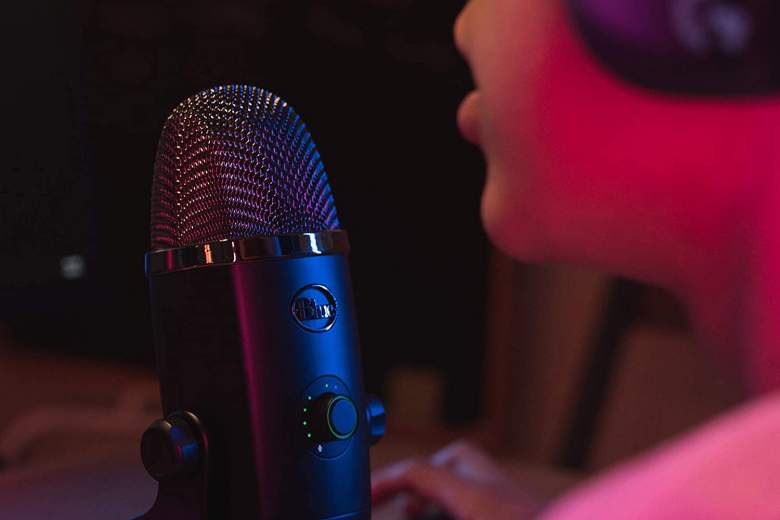
Blue
If you’re still streaming through a headset microphone (or God forbid, a webcam mic), you’re working at a severe disadvantage — even the most expensive headsets come with mediocre microphones, and you can dramatically improve your sound by stepping up to even an inexpensive desktop mic. The best microphones for Twitch or YouTube streaming will take you to a whole new level, both in terms of sound quality and overall convenience.
Desktop streaming microphones vary in features and quality, but they all tend to offer a quantum leap forward in sound quality thanks to a wider frequency response, significantly improved signal-to-noise ratio, and a better pickup pattern that can reject sound from everywhere except where you need to capture audio. In fact, many microphones let you choose the pickup pattern you need for any particular recording or streaming task, whether it’s sitting in front of the mic and streaming solo, conducting an interview, or capturing sound throughout a room or around a table.
No matter what your needs — recording, streaming, working solo or in a group — here are the top 8 desktop microphones you should consider.
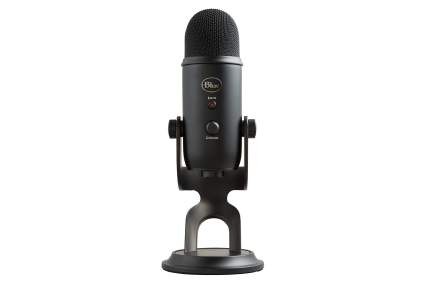
|
Amazon Customer Reviews
|
Price: $84.99 Shop at Amazon | Shop now Read our review |
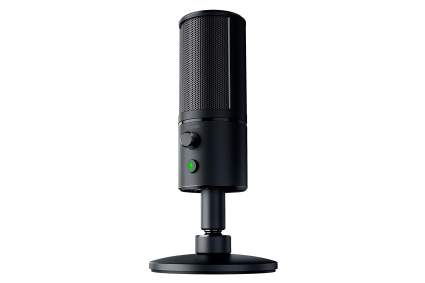
|
Amazon Customer Reviews
|
Price: $99.98 Shop at Amazon | Shop now Read our review |
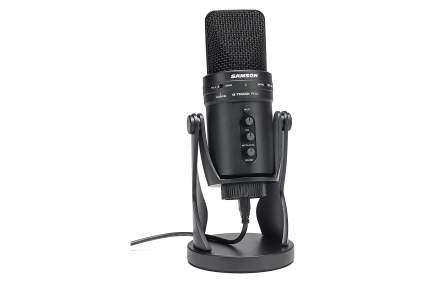
|
Amazon Customer Reviews
|
Price: $94.99 Shop at Amazon | Shop now Read our review |
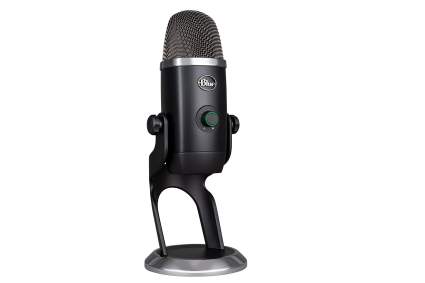
|
Amazon Customer Reviews
|
Price: $121.25 Shop at Amazon | Shop now Read our review |

|
Amazon Customer Reviews
|
Price: $104.92 Shop at Amazon | Shop now Read our review |
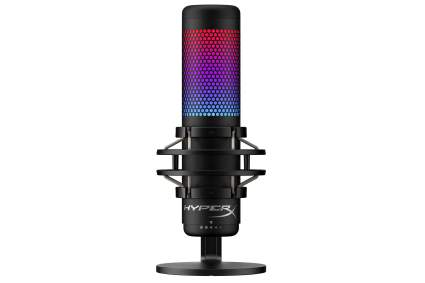
|
Amazon Customer Reviews
|
Price: $125.99 Shop at Amazon | Shop now Read our review |

|
Amazon Customer Reviews
|
Price: $94.99 Shop at Amazon | Shop now Read our review |
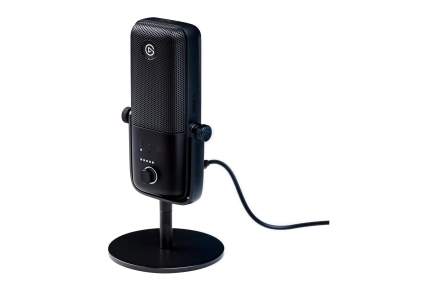
|
Amazon Customer Reviews
|
Price: $149.99 Shop at Amazon | Shop now Read our review |

|
Amazon Customer Reviews
|
Price: $77.00 Shop at Amazon | Shop now Read our review |
-
1. Blue Yeti
Pros:- Great retro aesthetic
- Four pickup patterns
- On-mic gain control
Cons:- Micro-USB connection
- Low inventory is driving up the price online
- No integrated pop filter
Pickup pattern: Cardoid, stereo, omni, two-way | Capsules: 3 condensers | Real-time monitoring: Yes | Connection: Micro-USB | Gain: Yes | Bit Depth/Sample Rate: 16-bit/48kHz | Frequency response: 20Hz – 20kHz | Max SPL: 120dB (THD: 0.5% 1kHz) | Weight: 3.5 pounds
When you think about desktop USB microphones, offs are really good you imagine something like the Blue Yeti; it has become iconic. It borrows the aesthetic of old-timey microphones from the 1950s, but comes in a variety of colors to suit your particular taste and is thoroughly modern on the inside.
The all-metal design is quite hefty, and the rubber no-skid pad on the bottom of the base keeps it from sliding if accidentally bumped. You can also thread it into a standard mic stand or place it in a shock mount. You get real-time monitoring through the 3.5mm headphone jack with a big volume dial in front, as well as a mute toggle. There is a single Mini-USB connector for attaching it to your computer. That’s right — Mini-USB, so don’t misplace this cable, You probably don’t own a replacement.
The cool stuff is around back. The Yeti has a 4-position selector that lets you choose among four mic patterns: cardioid, stereo, two-way and omni-directional. Cardioid is best for when you’re sitting directly in front of the mic, streaming audio solo, while stereo is probably the least useful mode: capturing live music or ambient room audio. Omni captures audio all around the mic, such as if you’re having a round-table conversation, and the two-way pattern is the hidden gem, great for a two-person interview with you and your subject on opposite sides of the mic.
You also get something that’s surprisingly rare on less expensive microphones: A gain control, so you can dial in the audio capture level.
The microphone is plug and play on Windows PCs, and sound quality is good, if not super. The 16-bit, 48kHz capture quality means it’s more than sufficient for virtually and voice-only streaming or recording project.
Looking for lighting for your streaming show? Be sure to check out the best lighting kits for streaming as well.
-
2. Razer Seiren X
Pros:- Lightweight and portable
- Professional looking
- Simple operation
Cons:- Picks up keyboard sound
- No gain control
- Only one pickup pattern
Pickup pattern: Supercardoid | Capsules: Single condenser | Real-time monitoring: Yes | Connection: Micro-USB | Gain: No | Bit Depth/Sample Rate: 16-bit/48kHz | Frequency response: 20Hz – 20kHz | Max SPL: 110dB (THD: <1% 1kHz) | Weight: 1.9 pounds
The Razer Seiren X is a great example of a desktop microphone that, while not at the top of the food chain, lets you step up in sound quality substantially if you were previously used to using an integrated webcam or headset microphone on a desktop computer for streaming. The microphone is solidly built and stands on a base with a hefty built-in shock mount to minimize noise from the desk it’s resting on. Weighing less than 2 pounds, it looks sharp and is also quite portable if you need to take it on the road.
There are only two controls on the mic: the front is home to a volume control and mute button. Something that’s conspicuously missing: a gain control. You will need to rely on your software to control the input level from the microphone. Not the end of the world, but not nearly as flexible as mics that provide this adjustment.
Razer built the mic with a single pickup pattern. While multiple patterns would provide more flexibility, the supercardioid pattern included here is a smart choice. It’s tightly focused to just pick up audio from directly in front of the mic, ignoring everything else in the room. Unfortunately, it does still tend to pick up desktop sounds like keyboard clatter, so it’s not perfect.
-
3. Samson G-Track Pro
Pros:- Three pickup patterns
- Record mic and instrument simultaneously
- Separate gain controls
Cons:- No mic stand adapter
- Not especially portable
- No shock dampening
Pickup pattern: Cardoid, omni, bidirectional | Capsules: 2 condensers | Real-time monitoring: Yes | Connection: USB-B | Gain: Yes | Bit Depth/Sample Rate: 24-bit/96kHz | Frequency response: 50Hz – 20kHz | Max SPL: 120dB (THD: <1% 1kHz) | Weight: 3.5 pounds
The Samson G-Track Pro has some unique features that make it stand out from the crowd of desktop microphones. It might look superficially similar to a mic like the Blue Yeti, but it has the ability to record both through the mic itself as well as accept line in from a musical instrument — and in fact, it can record both at once, either to a combined mono track, or it can send two discrete mono tracks to your computer at once. Yes, this is a superb microphone for streamers. But it’s a lot more, and gives you some unusual capabilities you won’t find elsewhere.
If you like buttons and switches, you’re in luck; the G-Track Pro is packed with them. There’s a 3-position switch to choose the pickup pattern. You can choose among cardoid, figure 8 (which is a bidirectional pattern for capturing a conversation or interview happening on opposite sides of the mic) or omni, which streams whole-room audio. There’s also the mono/2-track switch for selecting a single track or dual tracks when recording an instrument in the quarter-inch input. The most obvious controls, though, are volume dials — separate gains for the mic and instrument, as well as a volume for the headphones.
You can remove the G-Track Pro from the desktop stand, but that’s as far as it goes. Weirdly, where you’d expect to find a traditional adapter to mount the mic on a stand, you’ll just find the USB port. If you never plan to use the mic anywhere but on your desk, though, that’s probably not much of a problem.
-
4. Blue Yeti X
Pros:- Updated design with LED levels
- Enhanced 24-bit bit depth
- On-mic gain control
Cons:- Micro-USB connection
- No pop filter
- A little pricey
Pickup pattern: Cardoid, stereo, omni, two-way | Capsules: 4 condensers | Real-time monitoring: Yes | Connection: Micro-USB | Gain: Yes | Bit Depth/Sample Rate: 24-bit/48kHz | Frequency response: 20Hz – 20kHz | Max SPL: 122dB (THD: 0.5% 1kHz) | Weight: 3.9 pounds
The Blue Yeti X is an update to the venerable Yeti microphone — the one that put Blue on the map. Visually, they’re pretty similar, but there’s a lot going on here to make it a much smarter choice — if you have a choice. Both of these mics are on this list because availability or price might make one more viable than the other for you. Here’s the skinny: If you have a choice,m get the Yeti X. If the Yeti X isn’t available or is priced out of reach, the Yeti is still a great option.
The Blue Yeti X has the same four pickup pattern selector switch in back, but now the mic has four capsules rather than three — a great upgrade. The front volume control now has an 11-segment LED meter that wraps around the dial so you can see the headphone level at a glance. (It also integrates the mute control into a single multi-function button.)
The biggest upgrade, though, is the Blue Voice vocal effects in Logitech G HUB or Blue Sherpa. Here you get access to a suite of filtered and effects for altering your voice and cleaning up the audio.
-
5. HyperX QuadCast
Pros:- Four pickup patterns
- Integrated pop filter and shock mount
- Light-up sheath indicates mic is hot
Cons:- Sits a little short on desk
- No headphone volume control
- Some users might not like the bold design
Pickup pattern: Cardoid, stereo, omni, bi-directional | Capsules: 3 condensers | Real-time monitoring: Yes | Connection: USB | Gain: Yes | Bit Depth/Sample Rate: 16-bit/48kHz | Frequency response: 20Hz – 20kHz | Max SPL: 90dB (THD: 0.5% 1kHz) | Weight: 25 ounces
Ah, the HyperX QuadCast is a breath of fresh air. While most microphones are black on black on black, the QuadCast uses HyerX’s gamer-forward aesthetic by sheathing an internally illuminated red core inside the black honeycomb grille. And it’s even better; when you mute the mic, the illumination turns off, so you can tell at a glance — without having to scout out a small mute status light — if the mic is hot or not.
It includes four pickup patterns, easily selectable by a dial in the back (like the way the Blue Yeti works). You can choose among the front-focused cardioid mode, stereo, omni-directional, and bi-directional (which is your go-to pattern for face-to-face interviews). You’ll also appreciate that HyperX included goodies that are more typically accessories. The mic comes with an effective shock mount (the red elastic also looks sharp, as well) and a built-in pop filter. You can also take the mic off the desk stand and mount it on a boom or mic stand. Unfortunately, when you use it with the included desktop stand, it does tend to sit a little low on the desk, so you’ll need to hunch over a bit to get up close and personal with the pickup.
The controls are a joy to use. You mute yourself by tapping the touch-sensitive top, and the gain control is a dial that sits at the base of the microphone. There’s just one thing missing, though, and it’s a significant shortcoming: There’s no level control for the no-latency headphone connection. That’s too bad, because otherwise, this is one of the best streaming mics you’ll find.
-
6. HyperX QuadCast S
Pros:- Dual-zone RGB lighting in grille
- Four pickup patterns
- Integrated pop filter and shock mount
Cons:- Sits a little short on desk
- No headphone volume control
- Purists might wonder why a microphone needs lights
Pickup pattern: Cardoid, stereo, omni, bi-directional | Capsules: 3 condensers | Real-time monitoring: Yes | Connection: USB | Gain: Yes | Bit Depth/Sample Rate: 16-bit/48kHz | Frequency response: 20Hz – 20kHz | Max SPL: 90dB (THD: 0.5% 1kHz) | Weight: 25 ounces
The “S” makes all the difference. The HyperX QuadCast S is essentially the same microphone as the original QuadCast (also found in this list), but it adds dual-zone RGB lighting. Instead of the all-red-all-the-time light in the grille, you can use HyperX Ngenuity desktop all to control the upper and lower lighting zones with a variety of effects and the full range of 16 million colors. It’s the natural evolution of the original illuminated QuadCast microphone and is probably worth an extra $20 or so compared to the other model.
Otherwise, the QuadCast S is the same microphone. You get four pickup patterns, the built-in shock mount, built-in pop filter and tap-to mute touch sensitive top. And like the original mic, there’s no level control for the headphone connection.
-
7. Rode NT-USB MIni
Pros:- Very compact and portable
- Excellent audio characteristics
- Cool magnetic stand
Cons:- No gain control
- Only one pickup pattern
- Uncomfortably low to the desktop
Pickup pattern: Cardoid | Capsules: Single condenser | Real-time monitoring: Yes | Connection: USB-C | Gain: No| Bit Depth/Sample Rate: 24-bit/96kHz | Frequency response: 20Hz – 20kHz | Max SPL: 121dB (THD: <1% 1kHz) | Weight: 21 ounces
Whether you’re looking for portability or just a very diminutive mic that won’t eat up a lot of desk space, the Rode NT-USB Mini should be on your shortlist. Standing just 5.5 inches high and sitting on a base that’s 3.5 inches in diameter, it’s genuinely tiny. And that’s good or bad, depending on your perspective — sitting so short on your desk, it’s hard to get close enough to it to capture your voice without neck strain. This mic, like most, requires intimacy for the best sound quality, and you can’t do that sitting a foot or two away from it. The mic, which is permanently affixed to a U-bracket, snaps magnetically into the desktop base, which is cool, and you can also mount it on a stand with the included adapter. The mic is also very modern, connecting to your PC via USB-C.
You get a single pattern — cardioid — which is the workhorse pattern for most steamers anyway. Sound quality is excellent, enhanced by the built-in pop filter. So your tiny mic stays pretty small, with no need for a bulky pop filter mounted in front. Unfortunately, the mic has no integrated gain control, so you’ll need to adjust levels using your PC.
-
8. Elgato Wave:3
Pros:- Great build quality
- ClipGuard
- Excellent Wave Link software
Cons:- Only one pickup pattern
- Pop filter is extra accessory
- Mute button can intruduce pop
Pickup pattern: Cardoid | Capsules: Single condenser | Real-time monitoring: Yes | Connection: USB-C | Gain: Yes | Bit Depth/Sample Rate: 24-bit/96kHz | Frequency response: 70Hz – 20kHz | Max SPL: 120dB (THD: <1% 1kHz) | Weight: 20.6 ounces
While virtually any microphone can be used with Twitch or otherwise used to stream, few seem designed expressly for that purpose. The Elgato Wave:3, on the other hand, is intended for Twitch streamers, with solid specs designed for voices and bundled software that makes life simple for anyone who wants to talk through gameplay.
First and foremost, this is a single-capsule microphone with a tight cardioid pattern. You can’t choose any other patterns, so if you frequently need a mic for 2-person interviews or to include audio from the room at large, this might not be the best choice. The front panel of the microphone has a single control that you can use to adjust the gain, headphone volume, and also blend the mix between the microphone and the PC source volume. Around back, there’s a headphone input and USB-C port for plugging into your computer. Perhaps the mic’s coolest secret weapon, though, is the bunded desktop software Wave Link displays up to 8 of your open apps as a set of audio faders and lets you precisely blend them with the Wave:3’s audio. This way, you can easily stream your voice blended with a game or other software.
While there’s no pop filter included, Elgato sells an accessory pop filter made expressly for the Wave:3, sized perfectly for the mic. The mic does have an integrated anti-clipping feature called ClipGuard, which dos exactly what it sounds like and should prevent virtually all audio blow-outs. The mic is also easily removed from its desktop stand and can be mounted on a boom or mic stand.
-
9. JLab Audio Talk Pro
Pros:- Great visuals with LED level display
- Small and compact for travel
- Four pickup patterns
Cons:- Build quality is worrying
- LED ring light at base is basically invisible
- No shock protection or pop filter
Pickup pattern: Cardoid, stereo, omni, bi-directional | Capsules: 3 condensers | Real-time monitoring: Yes | Connection: USB-C | Gain: Yes | Bit Depth/Sample Rate: 24-bit/192kHz | Frequency response: 20Hz – 20kHz | Max SPL: 120dB (THD: 0.5% 1kHz) | Weight: 17.7 ounces
As new brands enter the desktop microphone space, we’re seeing more and more integrated lighting — especially decorative LED lighting — in their mics. The JLab Audio Talk Pro is just such a mic, featuring a gorgeous LED level display on the front of the mic and an LED ring light around the base. Weirdly, the light at the bottom is virtually invisible in normal use, so it’s not obvious why JLab included it.
This is a small and lightweight microphone that sits on a foldable tripod and is easy to take on the go, but thanks to the design, has no shock protection, so any contact you make with the desktop transfers directly to the mic — so keep your hands and legs clear. On the other hand, it has all the essentials: Four pickup modes, easily selected from the front, gain and volume controls, and a USB-C port on the bottom to connect to your computer.
There’s a lot here to recommend, though the microphone’s build seems somewhat fragile — if you travel with it, you should pack and handle it carefully. In fact, the long-term ruggedness of the mic is the major concern you might have in choosing this model.
How to Shop for a Microphone for Streaming on Twitch and YouTube
Microphones, like most audio gear, can be intimidating to shop for because of the arcane specifications and complicated jargon that describe all the gear. And while you can certainly get lost in a sea of arcane details, thee are just a handful of things to look for when shopping for a streaming microphone.
First of all, the first thing to ensure when shopping for a mic on your own is that it has some kind of USB port to connect it to your computer. This distinguishes an ordinary mic from a streaming mic; if all it has is an XLR connector, it's intended to be plugged into an amplifier or audio board, and you'll need additional, expensive gear to be able to connect it to your PC.
Next, decide what kind of pickup pattern you need to do the kind of streaming or recording you have in mind. There are four main kinds of pickup patterns:
Cardioid. This pattern focuses mainly o what's right in front of the mic and rejects virtually all sound from the side or behind. This is ideal for streaming solo from your desk.
Bi-directional. This picks up sound in front and behind the mic, and is commonly used for conversations and interviews with another person. If the only pickup pattern your mic supports is cardioid, both of you will need to crowd around the front of the mic.
Omnidirectional. This kind of mic pattern can pick up audio in every direction, good for a roundtable discussion.
Stereo. Best for musical performances, this is generally am omni pickup with multiple microphones for true stereo separation.
You might also give some thought to the kind of microphone you want. Most streaming mics are condenser mics, though occasionally you'll see dynamic mics. Dynamic microphones are more commonly found on stage rather than in streaming desktop mics. They're less sensitive and require more power, so for the most part you're probably better off with a condenser mic.
It's generally a good idea to avoid mics that don't include a gain control. If you can't dial in the gain of the microphone, you'll need to do it via software on the computer, which is far less convenient.
One final consideration: Most microphones have a headphone input and support what's called "real-time," "low latency," or "zero latency" monitoring. This lets you hear what's going on in the mic in real-time, not after a delay as the sound of your voice is routed to the PC, processed, and spit back out at you. Consider real-time monitoring essential for streaming; it's the only way to really know what your audience is hearing.
The Best Value in a Microphone for Streaming
Thankfully, there's an abundance of high-quality, easy-to-use microphones on the market, and many of them can probably make you quite happy.
Blue Audio's Blue Yeti is one of the oldest, most dependable, and best-sounding streaming mics available. It's hard to go wrong with that model.
A solid alternative is the HyperX QuadCast, a slightly more modern take that has most of the same features -- four pickup patterns and gain control, for example -- but adds an integrated shock mount and pop filter, along with a great mute feature.
Finally, if you do a lot of streaming work in which you overlay audio on PC audio from games or other apps, the Elgato Wave:3 is worth considering for its superb Wave Link desktop software.
See Also:
11 Best Noise Cancelling Headphones
7 Best Webcams for Twitch and YouTube Streaming
9 Best Laptops For Online College Students